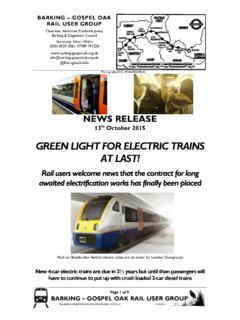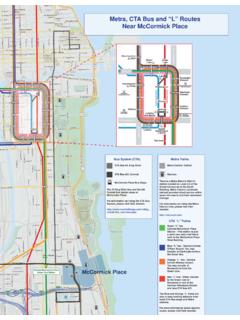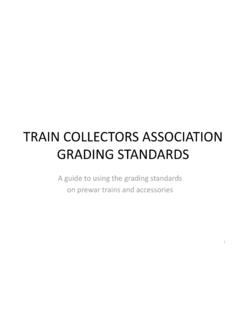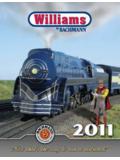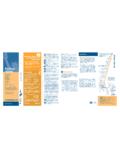Transcription of Ives Manufacturing Company - The Ives Train Society
1 ives Manufacturing Company . The ives Manufacturing Company , an American toy manufacturer from 1868 to 1932, was the largest manufacturer of toy trains in the United States from 1910 until 1924, when Lionel Corporation overtook it in sales. ives was founded in Plymouth, Connecticut by Edward ives , a descendant of Plymouth colony governor William Bradford. The Company initially produced paper dolls whose limbs moved in response to hot air, but soon began producing a wide range of toys, including a toy cannon that shot using real gunpowder and clockwork powered dolls and animals that could move. The clockwork toys were designed by Jerome Secor, Nathan Warner, and Arthur Hotchkiss and by the 1880s, ives was a leading producer of these toys.
2 Its emphasis shifted to trains as its designs were copied by other toymakers who were willing to sell them more cheaply. ives ' trains were made of tin or cast iron and initially powered by clockwork, but like later electric trains, some models could whistle and smoke. A fire in its main factory destroyed its tooling in 1900, which prompted a re- design for 1901 that resulted in ives ' first toy Train that ran on track. In the end this benefited the Company , as the insurance money permitted it to build a modern factory with state-of-the-art tooling. Although several companies were selling electric trains at the time, ives opted to remain with clockwork, partly because many homes still lacked electricity.
3 Initially, ives ' greatest competition came from German imports, and not from domestic manufacturers. ives ' response was with marketing, which it directed at its target audience, the twelve-year-old boy. Its campaigns addressed boys as business partners, telling them that the success of ives ' fictional railroad, ives Railway Lines, depended on their shrewd management. This worked, building brand loyalty. ives released its first electric trains in 1910, partially in response to companies such as American Flyer undercutting its prices on clockwork trains. ives initially produced electric trains in O gauge and 1 gauge. ives ' Train sales continued to decline in the face of increasing competition and Lionel's greater momentum, the latter having released its first electric trains nearly a decade earlier.
4 Meanwhile, construction toys were gaining in popularity, so in an effort to re- diversify, ives released a Meccano and Erector Set-like construction toy in 1913. Although it offered parts its competition did not, the set was not very successful and ives withdrew it from the market in 1917. World War I had mixed effects on the Company . On one hand, it eliminated imports from Germany, increasing ives ' share of the market. However, ives ' geographic location made it difficult to bring in the materials it needed to make trains, and also made shipping finished products difficult. Lionel and American Flyer, being headquartered in New York City and Chicago, respectively, did not face that challenge.
5 Additionally, ives ' isolation made it impossible for ives to gain lucrative wartime government Manufacturing contracts. As a result, ives did not benefit financially from the war. After the war, ives , along with competitors Lionel and American Flyer, lobbied successfully for protective tariffs to promote the fledgling American toy Train industry. As a result, there was very little foreign competition after World War I, especially at the high end of the market where ives had positioned itself. The seasonal nature of Train sales continued to cause concern for ives , and Harry ives , Edward ives ' son and successor, sought one last time to diversify by selling toy boats, which he hoped would support the Company through strong summer sales.
6 The first boats, released in 1917, were powered by a clockwork engine from an ives O gauge locomotive. However, the designs were unrealistic looking, lacking the costly detail that was the highlight of competing German designs, and had a tendency to sink easily. Additionally, since ives did not use a primer when painting the boats, the paint flaked off easily. ives had difficulty adapting its methods for designing and building trains to work for boats. Despite the problems, ives continued producing the boats until 1928. Few ives boats exist today, but it is unclear whether this was due to lack of popularity or their propensity to sink. Harry ives had a heated professional relationship with Lionel founder Joshua Lionel Cowen, in which they traded lawsuits and, starting in 1915, Lionel criticized the quality of ives ' offerings in print advertisements, calling its cars flimsy and showing a cast-iron ives locomotive shattering into 15 pieces when dropped from a table, while a Lionel locomotive dropped from the same height would survive with only dents.
7 Other ads criticizing ives ' quality appeared, but they always compared ives ' cheapest products with Lionel's priciest offerings. Although ives could rightly claim that its lithographed offerings were more realistic than Lionel's simple enameled two-color cars, Lionel, taking a cue from ives , targeted advertising straight at children, claiming its cars were the most realistic and that its paint jobs were more durable. ives ' subdued responses did little to counter Lionel's claims, only calling its competitors (including Lionel) imitators whose technology was "12 years behind." It was no match for Lionel's bold and brash ads. Additionally, Lionel's trains generally were priced lower, or, in instances where their price was comparable to ives , they were larger, making them appear to be a better value for the money.
8 As a result, Lionel continually gained ground on ives , finally overtaking them in sales in 1924. In 1921, ives abruptly discontinued its slow-selling 1 gauge trains in favor of wide gauge trains, a standard Lionel had introduced several years earlier and called "Standard Gauge". ives did not call its trains Standard Gauge, as Lionel had trademarked the name. While ives was inconsistent in what it called its larger-gauge trains, it most frequently called it wide gauge. Numerous other companies also entered the wide gauge market in the early 1920s, increasing consumer interest in the size and forcing the manufacturers to innovate in order to survive. In 1924, ives introduced a locomotive engine that would change directions when its power flow was interrupted, a feature that Lionel would not offer for another two years.
9 Even after Lionel's introduction, ives ' offering was unique in that it offered a neutral position as well as forward and reverse, and the engine's headlight continued to operate even when the Train was in neutral. ives charged a premium for this feature, which it dubbed the "e-unit" (the "e" stood for 'electronic,' although it was a mechanical device), and it increased sales. This was not enough for ives to re-take its former place as market leader--by 1926, Lionel's revenue was twice that of ives '--and, worse yet for the Company , ives was losing money by the mid-1920s. This was worsened by ives ' attempts to compete at the low end of the market, where, unlike its competition, it sold its entry-level models at a loss.
10 If ives ' low-end products were higher quality than its competitors, it benefited its customers, not the Company . In an effort to turn around the Company , Harry ives relinquished his presidency in 1927, becoming chairman of the board and bringing in an outsider, Charles R. Johnson, as president, but problems continued and ives ' largest creditor sued in 1928. ives filed for bankruptcy, reporting liabilities of $188, As ives already had $245,000 in Christmas sales lined up, Johnson petitioned for a private sale and a quick settlement. The motion for a private sale was denied. On July 31, 1928, ives was purchased by Lionel and American Flyer for $73,250. The low price in comparison to the Company sales was presumably due to liens on ives '.
